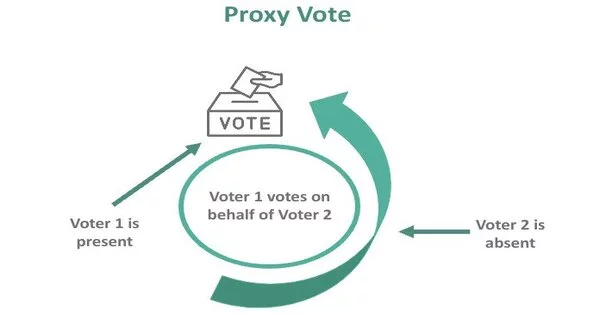Proxy voting is a procedure that allows shareholders or members of a company to delegate their voting rights to another person or entity known as a proxy. Shareholders who are unable to attend a meeting or vote in person can still participate in the decision-making process through this arrangement.
Proxy voting is a type of voting in which a member of a decision-making body may delegate voting power to a representative in order to cast a vote in their absence. The representative could be another member of the same body or someone from outside. A person so designated is known as a “proxy,” and the person who designates them is known as a “principal.”
Proxy appointments can be used to create a voting bloc with greater clout in deliberations or negotiations. Proxy voting is a particularly important corporate practice; in the United States, investment advisers frequently vote proxies on behalf of their client accounts.
Liquid democracy, a family of electoral systems in which votes are transferable and grouped by voters, candidates, or a combination of both to create proportional representation, and delegated democracy are related topics. Another topic related to this is the so-called Proxy Plan, or interactive representation electoral system, in which elected representatives would have the same number of votes as they did in the previous election. In 1912, Oregon held a referendum on whether to adopt such an electoral system.
Here’s how proxy voting generally works:
- Proxy Appointment: The shareholder or member completes a proxy appointment form, which authorizes another person to vote on their behalf. The appointed proxy could be an individual, such as a family member, friend, or lawyer, or it could be an institution, such as a bank or a proxy advisory firm.
- Proxy Disclosure: In many cases, proxy rules require the proxy to reveal their identity and relationship to the shareholder or member. This promotes transparency and helps to avoid conflicts of interest.
- Proxy Statement: The organization sends a proxy statement to its shareholders or members prior to a meeting or vote. This document contains information about the issues to be voted on, as well as any relevant information or recommendations.
- Proxy Voting Choices: The proxy holder votes on behalf of the absent shareholder or member in accordance with the instructions provided. If the appointing shareholder did not provide specific instructions on certain matters, the proxy may have discretion to make decisions.
- Voting Results: Following the voting deadline, the organization tallies the votes, taking into account both those cast in person and those submitted via proxy. The results are then announced, and the outcome determines the organization’s actions or decisions.
Proxy voting is used in a variety of contexts, including corporate shareholder meetings, nonprofit organizations, mutual funds, and political elections. It enables greater participation, especially when shareholders or members are unable to attend meetings due to distance, scheduling conflicts, or other factors.
















